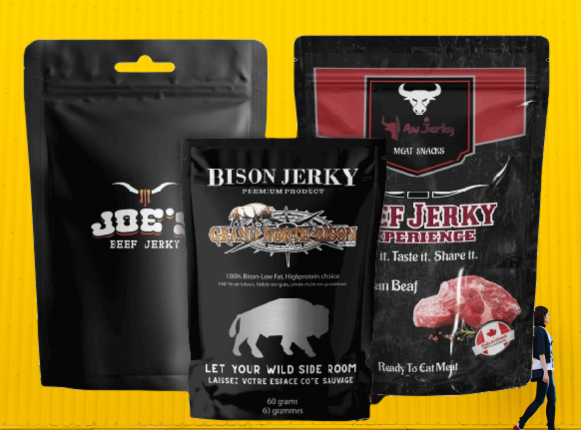Introduction:
Jerky, a popular snack enjoyed worldwide, has come a long way from its roots as a survival food for early humans. Today, it is a gourmet treat available in various flavours and meat options. However, what often goes unnoticed is the packaging that plays a crucial role in preserving the freshness and flavour of jerky – the jerky bag. In this comprehensive guide, we will explore the various aspects of Jerky Bags, from their design and materials to their impact on the quality of the beloved dried meat snack.
The Evolution of Jerky Bags:
Before delving into the specifics of Jerky Bags, it’s essential to understand the journey of jerky itself. Jerky has been around for centuries, with its origins traced back to indigenous people who used drying techniques to preserve meat for sustenance during lean times. The concept of drying meat slowly evolved into the delicious jerky we know today, featuring a variety of meats, flavours, and textures.
Understanding Jerky Bags:
Jerky bags are specialised packaging designed to protect jerky from environmental factors that can compromise its quality. These bags serve several purposes, including:
Preservation:
Beef Jerky bags act as a barrier against moisture, light, and air, which are the primary culprits in causing spoilage and degradation of jerky quality.
Flavour Retention:
The airtight seal provided by beef jerky bags helps in retaining the unique flavours and seasonings infused into the dried meat during the marination process.
Extended Shelf Life:
Properly designed beef jerky bags contribute to the extended shelf life of the product, allowing consumers to enjoy their favourite snacks over an extended period.
Jerky Materials:
Beef Jerky bags are typically made from materials that provide an effective barrier against external elements. Common materials include:
Multi-layered Films:
Most beef jerky bags are constructed using multi-layered films that combine materials like polyester, polyethylene, and aluminium. This combination enhances the barrier properties, preventing moisture, oxygen, and UV light from affecting the jerky.
Mylar:
A type of polyester film with high tensile strength and excellent barrier properties, Mylar is often used in jerky bag construction.
Foil:
Aluminium foil is known for its exceptional barrier against moisture and light, making it a popular choice in beef jerky bag manufacturing.
Features of Jerky:
Zipper Seals:
Many beef jerky bags come equipped with zipper seals, allowing consumers to reseal the bag after opening, thereby maintaining freshness.
Clear Windows:
Some beef jerky bags incorporate clear windows, providing a sneak peek into the product without compromising its freshness. These windows are often made from transparent materials such as polyethylene.
Deoxygenation Valves:
To further enhance freshness, some high-quality jerky bags feature deoxygenation valves that allow the removal of oxygen from the package.
Environmental Considerations:
As the world becomes increasingly conscious of environmental sustainability, the packaging industry, including jerky bags, is adapting to eco-friendly alternatives. Some manufacturers are exploring biodegradable and compostable materials to reduce the environmental impact of packaging.
Storage and Handling:
Proper storage and handling are crucial to maintaining the quality of jerky. Consumers are advised to store beef jerky bags in cool, dry places, away from direct sunlight and heat sources. Additionally, resealing the bag after each use helps preserve the freshness of the remaining jerky.
Jerky Innovations:
Innovation in packaging technology is a constant in the food industry, and beef jerky bags are no exception. Some recent innovations include smart packaging with QR codes that provide information about the product’s source, processing, and nutritional content. Interactive packaging elements contribute to a more engaging consumer experience.
Material:
Beef Jerky bags are typically made from multi-layered materials that provide barrier properties to protect the jerky from moisture, light, and oxygen. Common materials include laminated films such as PET (Polyethylene Terephthalate), PE (Polyethylene), and nylon.
Barrier Properties:
The multi-layer structure of beef jerky bags helps to create a barrier against external factors that can affect the quality of the jerky. These barriers prevent moisture from entering the bag, which is essential for maintaining the texture and flavour of the dried meat. Additionally, they protect the jerky from exposure to light and air, which can lead to oxidation and spoilage.
Resealable Features:
Many beef jerky bags come with resealable features such as zip locks or heat-sealed closures. These features allow consumers to reseal the bag after opening, helping to extend the shelf life and keep the jerky fresh.
Custom Printing and Labelling:
Customised Jerky bags often have custom printing and labelling to convey brand information, product details, and nutritional facts. The design and branding on the packaging can influence consumer choices and contribute to the overall marketing strategy of the jerky product.
Sizes and Styles:
Customised Jerky bags come in various sizes and styles to cater to different packaging needs. Some are designed for single servings, while others are larger and suitable for bulk packaging.
Stand-up Pouches:
Many customised jerky bags are designed as stand-up pouches, which offer convenience in terms of storage and display. The stand-up feature makes it easy for the bags to be placed on store shelves, and it also provides a user-friendly experience for consumers.
Regulatory Compliance:
Beef Jerky bags must comply with food safety and packaging regulations. Manufacturers need to ensure that the materials used in the bags are food-grade and safe for storing consumable products. This includes adherence to regulations regarding contact with food, as well as guidelines for labelling and nutritional information.
Tear-Notch Technology:
Some beef jerky bags feature tear-notches, making it easy for consumers to open the packaging without the need for scissors or other tools. This adds to the convenience of the packaging.
Conclusion:
In conclusion, the humble beef jerky bag plays a significant role in preserving the quality, flavour, and shelf life of everyone’s favourite dried meat snack. From traditional multi-layered films to cutting-edge smart packaging,beef jerky bags have evolved alongside the snack itself. As consumers become more environmentally conscious, the industry is likely to witness further advancements in sustainable packaging solutions. Custom Product Packaging Canada is used to wrap the product because they have the high packaging products for their customers. The next time you enjoy a bag of jerky, take a moment to appreciate the thought and technology that went into creating the perfect packaging to keep that delicious snack fresh and flavorful.



